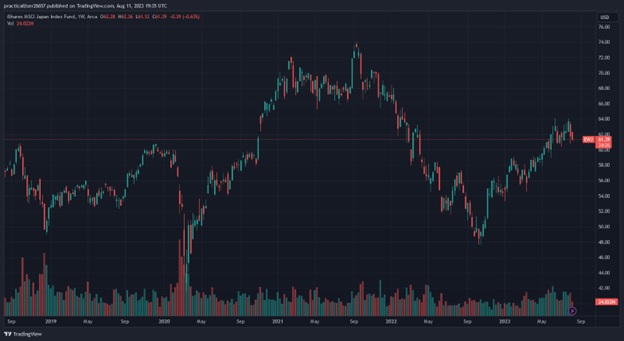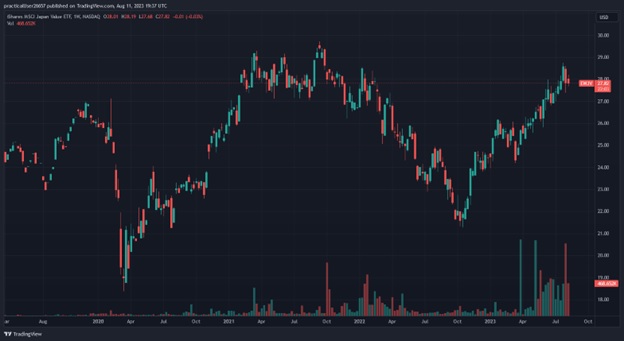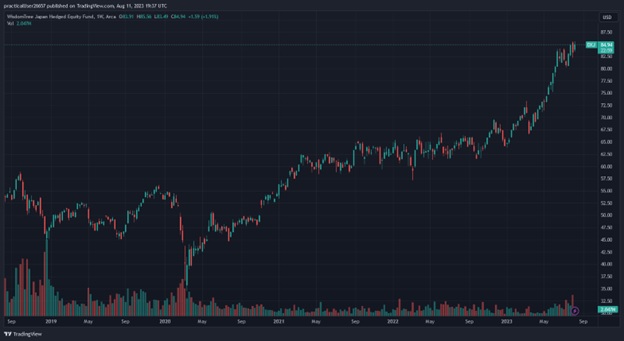This year has been one of the contradictions in the U.S. stock market, but in July, Morgan Stanley highlighted several warning signs that suggest a bust may hit U.S. equities soon. Higher-than-usual bond-market volatility, resilient Treasury rates, and the strong U.S. dollar could signal trouble. Due to these concerns and others, investors may want to consider Japan, one of the safest and most politically stable countries in the world, and the ETFs that target that country.
In fact, Morgan Stanley highlighted Japanese equities as “good hedges for a peaking U.S. dollar.”

There are some excellent exchange-traded funds that offer exposure to Japan. The largest Japan ETF is the iShares MSCI Japan ETF (EWJ), which has $13.4 billion in assets. EWJ is up 12.5% year to date. The ETF’s top 10 holdings are Toyota, Sony, Mitsubishi UFJ Financial, Keyence, Tokyo Electron, Mitsubishi, Sumitomo Mitsui Financial, Hitachi, Shin-Etsu Chemical, and Daiichi Sankyo.

The iShares MSCI Japan Value ETF (EWJV) switches out some of EWJ’s holdings for names like Honda and Takeda Pharmaceutical. Other options that approach the Japanese equity market in different ways include the WisdomTree Japan SmallCap Dividend ETF (DFJ), the Franklin FTSE Japan ETF (FLJP), and the JPMorgan BetaBuilders Japan ETF (BBJP).
Concerns About Investing in Japan ETFs Now
Despite the attraction of the Japanese market, current events there may be giving some investors pause. For example, the Japanese stock markets have reached levels not seen in over 30 years, which eventually resulted in the so-called “lost decade.”
However, the benchmark Nikkei 225 currently remains well below its record high of 38,915 reached in December 1989. That bubble burst in early 1990 when the Bank of Japan tightened its monetary policy, sending real estate and equity prices plummeting. By September 1990, the Nikkei had plunged to half its record high.
Now, the BoJ’s recent policy tweak is giving some investors déjà vu. Known for its notoriously dovish stance, the central bank announced “greater flexibility” in its monetary policy — by loosening its yield curve control.
The yield curve control is a long-term policy that has the central bank set a target interest rate and then buy and sell bonds to the extent needed to reach that target. The BoJ continues to target a 0% yield on its own 10-year government bonds.
The BoJ Shocks the Markets
In a policy statement in late July, the central bank said it would continue to let the 10-year Japanese government bonds (JGBs) fluctuate between 0.5 percentage points on either side of that 0% target. However, the BoJ also said it would expand its price tolerance from 50 basis points to a full 100 basis points.
The central bank emphasized “extremely high uncertainties” in its outlook for inflation, warning that maintaining strict yield caps will hinder the functioning of the bond market and boost market volatility when upside risks appear.
While this might seem like a very minor adjustment, it’s significant for the BoJ. As a result, many investors initially wondered whether more substantial policy adjustments were just around the corner. However, a few days later, BoJ officials clarified that they “do not have an exit from monetary easing in mind.”
This was excellent news for investors because the central bank’s tightening aimed at reining in Japan’s overheated real estate market in 1990 was partially to blame for the lost decade.
Why This Time Looks Different
Analysts also note some other key differences between Japan’s current situation and where it stood in the 1990s. For example, one analyst told CNBC that although real estate prices in some parts of the Tokyo metropolitan area have skyrocketed, it isn’t a nationwide issue.
Additionally, he said Japan’s currently high inflation is the result of increased import costs due to a weaker yen and high commodity prices. In the 1980s, the Japanese enjoyed rapid economic growth, low unemployment, and easy credit access, which drove that equity rally. Then when the BoJ started hiking interest rates, it plunged Japan into a 10-year financial crisis now referred to as “Japan’s lost decade.”
Today, Japanese firms are posting better-than-expected earnings results due to the weak yen and enjoying stronger economic performances outside their country. Finally, Nikkei said earlier this year that share repurchases by Japanese firms were on track to reach a 16-year high in 2023.
What All This Means for Japan-Focused ETFs
One last key difference between now and Japan’s lost decade is the strength of the yen. Despite the nation’s persistent recession in the 1990s, the yen was surprisingly strong. However, many years of loose monetary policy and the BoJ’s recent pledge not to start tightening also suggest this time may be different.
As a result, investors looking at Japan should consider how to deal with the weakening yen, which tumbled to a 20-year low versus the dollar last year. Foreign investors have long debated the pros and cons of a currency-hedged approach to deal with the weakened yen.
The weak yen frequently weighs on unhedged Japanese assets. Returns on overseas equities are made up of any price appreciation on those assets, the income from them, and the returns on the currency relative to the investor’s domestic currency. Thus, investing in assets priced in a weak currency like the yen weighs heavily on equity returns.
Potential Complications
However, other factors make this debate more difficult. The yen’s safe-haven status usually causes it to strengthen during weakness in the equity market. As a result, Japan’s perennially ultra-low interest rates make the yen an attractive currency to conduct carry trades in. This strategy involves borrowing money in low-rate markets and then investing it in higher-rate markets.
These dynamics actually boost unhedged yen positions for foreign investors during periods of market weakness, which is why sometimes an unhedged approach may be better for Japanese equities. Fortunately, ETFs offer both hedged (like those above) and unhedged options, like the WisdomTree Japan Hedged Equity ETF (DXJ) or the iShares Currency-Hedged MSCI Japan ETF (HEWJ).
See More: “Why a July Fed Rate Hike Helps Japan ETF DXJ“

Currently, DXJ is up 32% year to date while HEWJ has gained 28%, versus the up-to-13% returns notched by many unhedged ETFs year to date. However, this situation could quickly reverse when the market weakens significantly. Thus, investors might want to watch for the best time to switch to unhedged Japan ETFs.
Charts via TradingView
For more news, information, and analysis, visit the ETF Building Blocks Channel.

